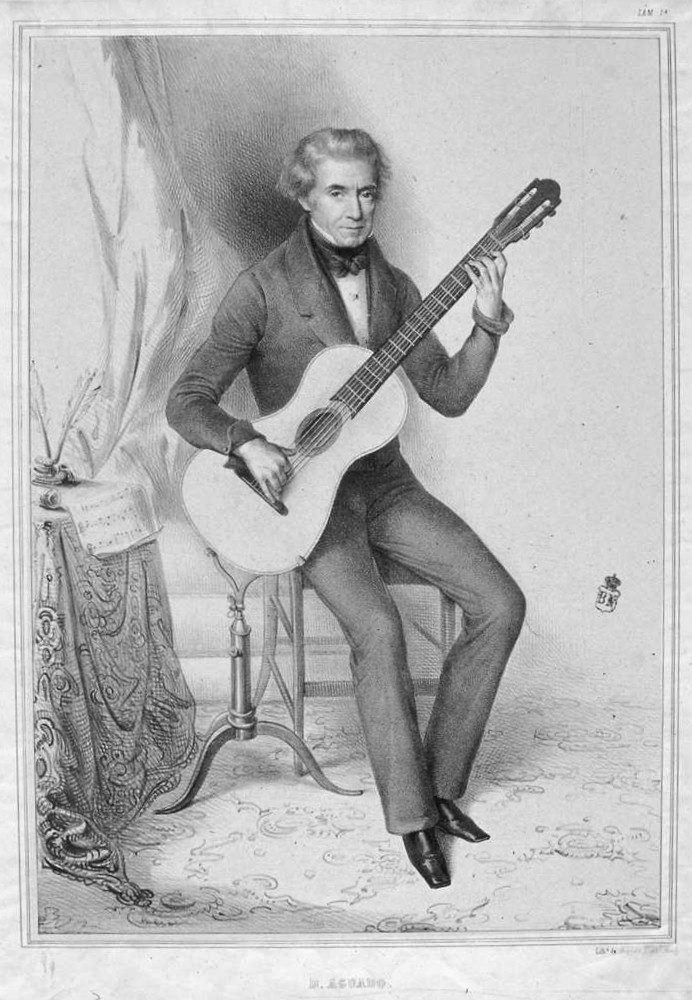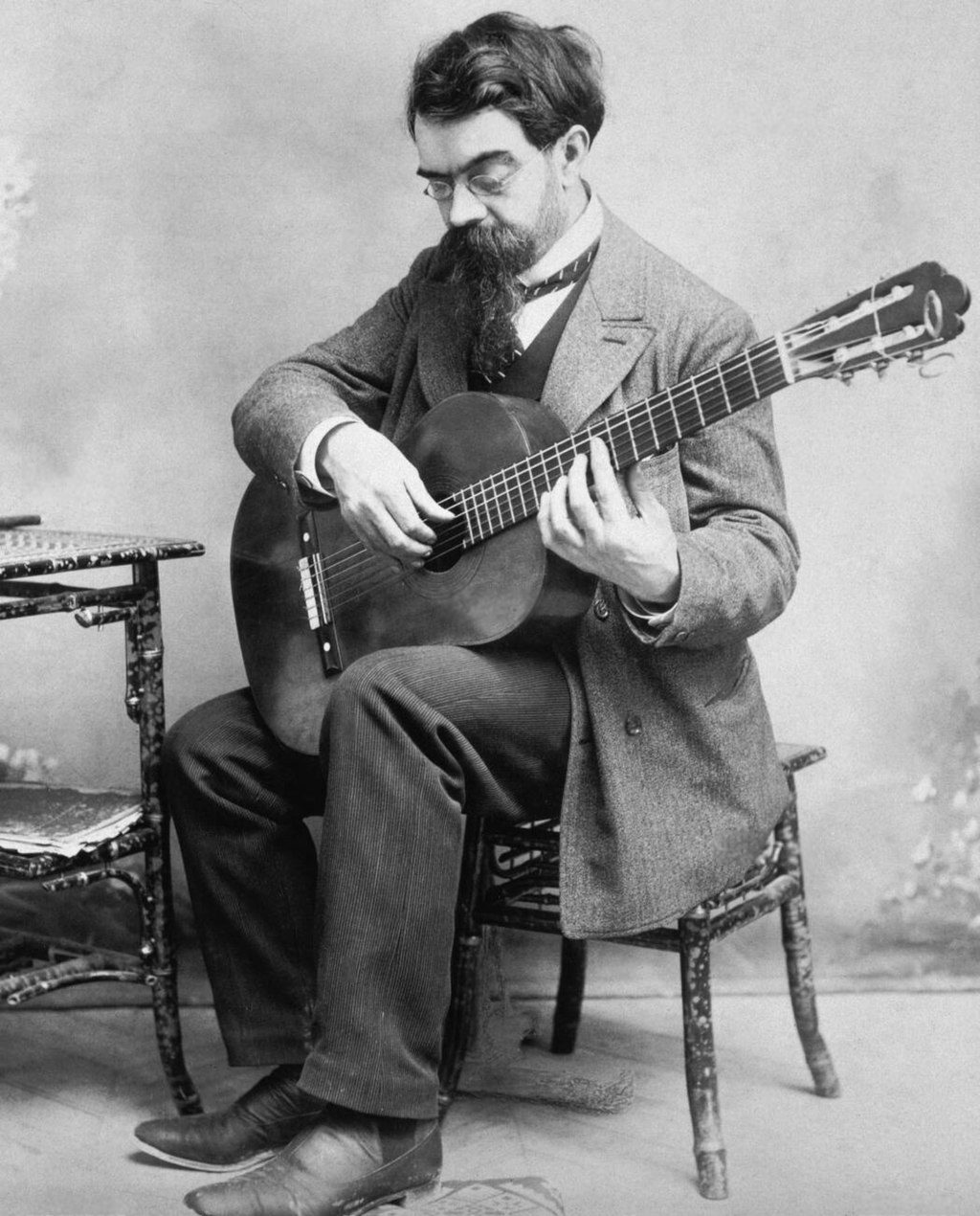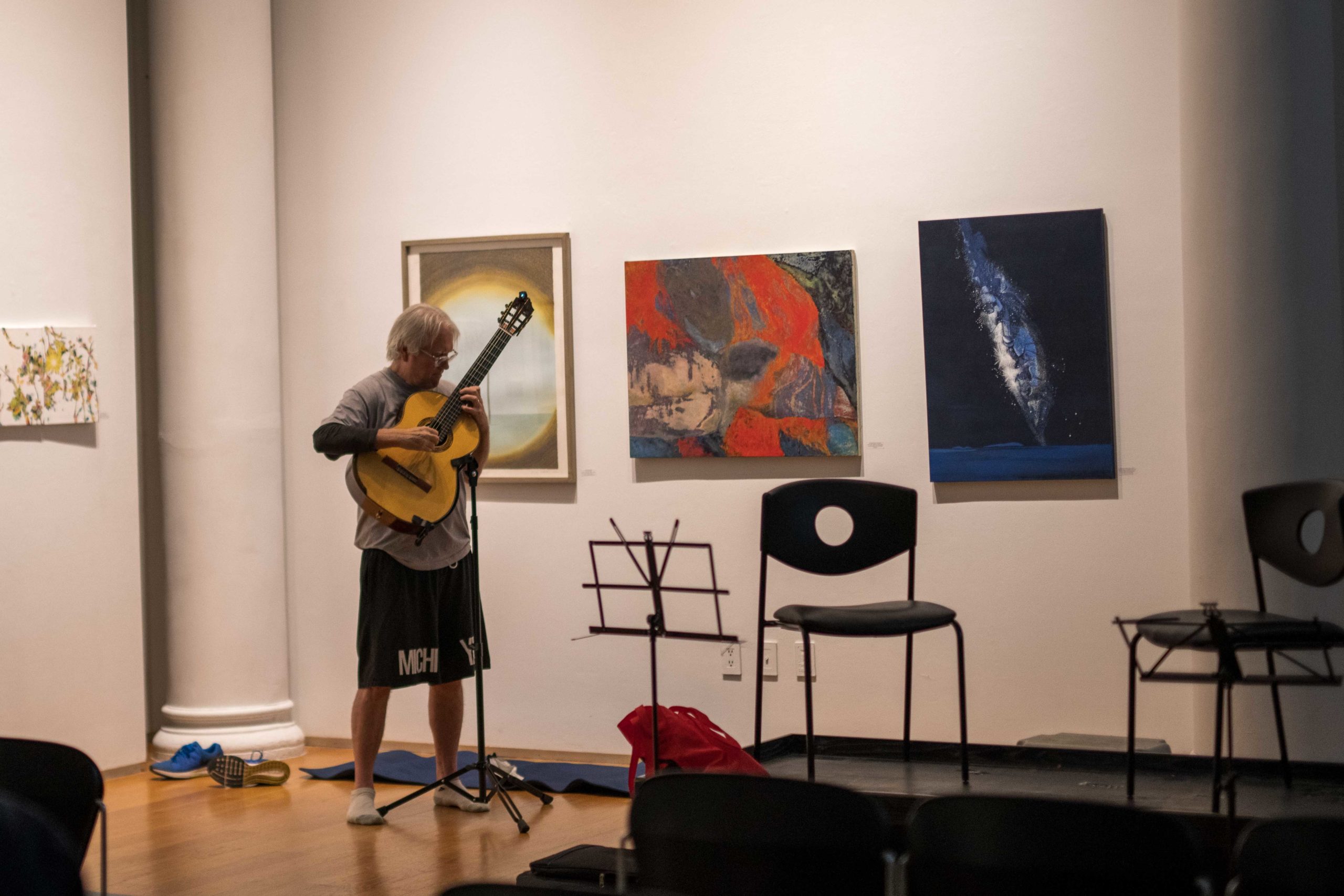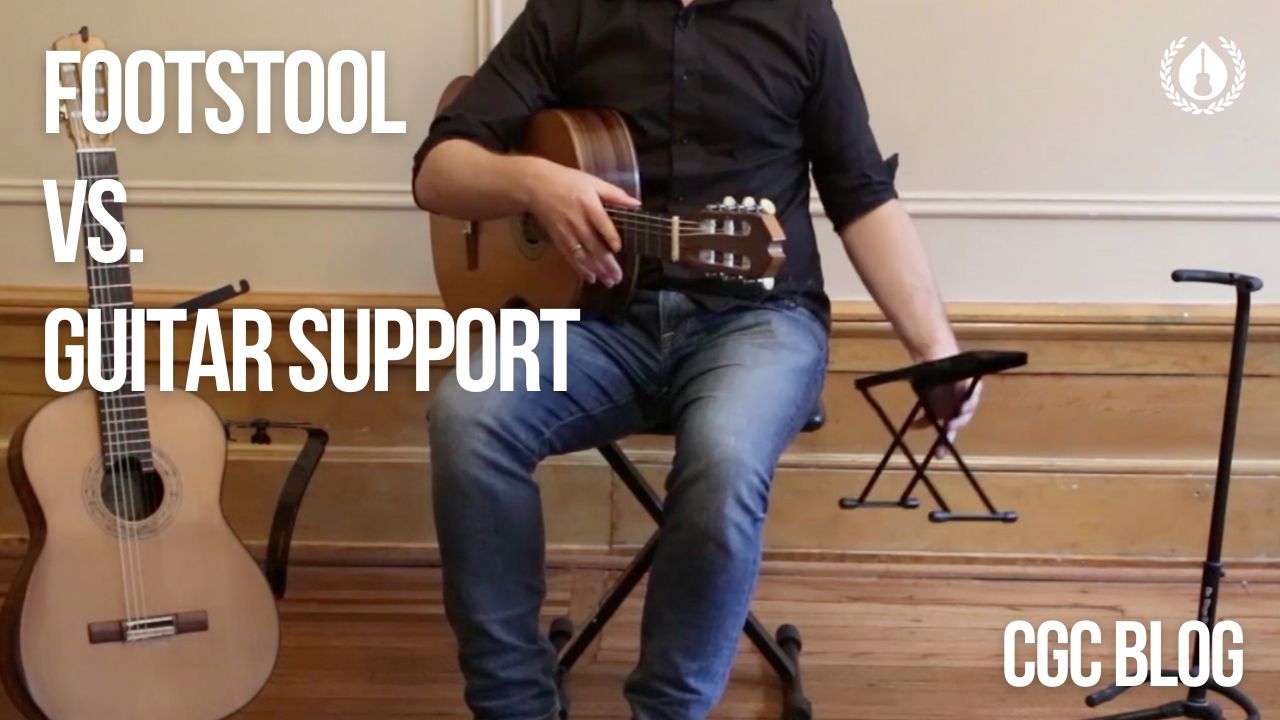Footstool vs Guitar Support
The footstool vs guitar support debate is relatively new, but a consensus has emerged among guitar teachers. So should you use a footstool or a guitar support when playing classical guitar? These days most guitar teachers agree that a guitar support that allows both feet to be flat on the ground will be best. This provides an ergonomic approach that will allow you to play for long periods of time without pain. But it wasn’t always this way. In this article we’ll look at the history of different ways to hold the instrument along with the pros and cons of each approach.
The 19th Century
Fernando Sor: Pioneer of Ergonomic Technique
According to Fernando Sor’s Method for the Guitar, first published in 1830, the popular way of holding the guitar at the time was with the waist of the guitar over the right leg. This is very much how most hold the acoustic or electric guitar today when seated. However, Sor finds this position limits the position and mobility of the left hand because it leaves the neck too low to the body.
While it is not very common, there are modern classical guitarists who also hold the instrument this way today. The most notable is Spanish classical guitarist Ricardo Gallén. Gallén folds his right leg over his left and holds the waist of the guitar over his right thigh, exactly as Sor describes.

Sor also mentions that in France and Italy the guitar was held over the left leg with the neck elevated in the correct way, but in a way that contorted the body and caused the right shoulder to drop to get the guitar in this position. According to Sor, this position caused “the tendons to act continually to keep the arm in an unnatural position, which would make me feel difficulty, and indeed often pain, when moving the joints of the fingers.”
Sor’s solution to both of these issues was to place a table over his left leg and allow the left lower bout of the guitar to rest against a corner of the table (thus providing support to raise the neck without distorting the shoulders or body). What is most important to recognize here is that Sor sought an ergonomic solution for posture and the sitting position so the body would be at balance and without tension while holding the guitar.
Dionisio Aguado and his Tripodison
We see a similar solution to Sor’s in Aguado’s Method (1843) – though with a different purpose in mind. Aguado recommends using a device he invented called a tripodison, which held the guitar in the correct angled position so that the body of the performer would not interfere with the vibrations of the instrument. (Unfortunately it seems the device was not very practical and it did not catch on.)

Coste, Carcassi, and the Footstool
When Napoléon Coste revised Sor’s Method (around 1851) he recommended using a “stool 12 cm high” (with a slightly taller stool for women). This must have also been a popular approach at the time, as this is likewise what Carcassi recommends in his Method (1836), and for very similar purposes to those of Sor:
“To hold the guitar well, it is necessary to sit down on a seat a little higher than those which one uses ordinarily; place the left foot on a stool of a height proportionate to that of the seat on which one is sitting; then one spreads the right leg while stepping back the foot a little; the left leg retains its natural position; the weight of the body rests largely on the left thigh.
“Once well seated in this way, the guitar is placed transversely on the left thigh . . . this position is preferable to any other because it offers three points of support for the instrument which is in balance without the hands having to hold back: this is the disadvantage of other positions, which often contribute to added tension” (Carcassi, Method Op.59, p.9).

By the turn of the 20th century it is clear that the footstool became the almost universal way to hold the instrument. Neither Sor’s table nor Aguado’s tripodison ever became popular. We can see this clearly in images of Tárrega and his students, such as Miguel Llobet.
But it was the young Andrés Segovia who really made the footstool the norm. Segovia even traveled with a large and special footstool — it was an important part of performance for the Spanish maestro.

The 20th Century to Today
Ergonomics
Really only within the past few decades there has been a greater emphasis on ergonomics in guitar technique. (Though it should be kept in mind Sor and Carcassi were champions of this approach nearly two hundred years ago!) In part, this approach has arisen in response to the pain and discomfort the footstool caused in performers for decades now. Because the footstool raises one leg while the other stays flat on the ground, the sit bones at the pelvic floor become misaligned, which can cause discomfort, pain, and even injury in the lower back. This is especially true with frequent use over a long period of time.
The Guitar Support
Thus was born the guitar support. These devices provided the necessary support for the guitar to get in a proper position while both feet are flat on the ground. Guitar supports take tension away from the pelvis and lower back. When guitar supports like the A-Frame and Ergoplay first hit the market, they instantly provided relief to those who had experienced pain using the footstool.
Today there are many different kinds of supports: those that attach with suction cups, those with magnets, those that clamp onto the body of the instrument, and even one which is a cushion placed between the guitar and the leg. Each is unique and has advantages and disadvantages, so it’s up to each individual to choose the support that fits them best.
Whichever you choose, we highly recommend using a support that allows both feet to be flat on the ground to avoid the pain and discomfort that can inevitably come with use of the footstool.
Pros vs Cons of the Footstool and the Guitar Support
Footstool – Pros
- More secure feeling of connection with the instrument
- Easy and quick height adjustment
- Very light and portable
Footstool – Cons
- Raises the left sit-bones, which can be damaging for the back over time
- Not as easy to set up and put away for performance
- Only height can be adjusted
Guitar Support – Pros
- Easily fastens to instrument for quick readiness
- Allows you to put both feet on the ground, thus not placing strain on pelvis/back
- Places the guitar in the correct position with a high amount of variability to find the position that is right for each individual
Guitar Support – Cons
- Not all guitar supports are as portable
- Many use suction cups, which can damage some finishes, or magnets, which can be difficult to install
- Not as secure of a connection with the instrument as the footstool
- Height adjustments are not always easy and simple
The Strap / Guitar Stand
A popular way of holding lutes, theorbos, baroque guitars, and vihuelas was to use a strap. We see examples of this in countless paintings from the time. While this had fallen out of use for the classical guitar even by the time of the nineteenth-century pedagogues, there are some who are reviving its use today.
A great example of this approach would be the young Russian guitarist Anton Baranov, especially when playing on a Romantic guitar. The guitar is still in a good elevated position for the left hand, but there is much more freedom of motion and the body is able to be much more stable without being contorted while standing.

Another device that allows the guitarist to stand up while playing is the guitar performer stand (first manufactured by König and Meyer). This is very similar to Aguado’s tripodison, but raises high enough to allow the performer to stand. Ben Verdery has begun to use this recently. To the right is a picture of Ben warming up with his guitar performer stand before a CGC concert in New York from June 2022.
Recently a Portland, Oregon guitarist named Travis Johnson has created a similar device, which you can check out here.

Conclusion
While the way guitarists hold the guitar has changed over time and with new technologies, and while some find unique ways to hold the instrument to suit their bodies or preferences, there is still no substitute for an ergonomic position of the body while holding the guitar. This was both Fernando Sor and Matteo Carcassi’s preference nearly 200 years ago, and it is still the most recommended way of holding the guitar today. A guitar support that allows both feet to remain on the floor or that allows the player to stand up while playing are the most ergonomic options.


Great article! I decided right away that the Sageworks support was for me, but I have a backup footstool. I’d also love to try out the standing support.
Very interesting reading, I use a footstool nowdays but I am thinking about ordering a good guitar support and see how that feels.
Thanks for al the information about this!
Magdalena
I’ve used the Sageworks Umbra for the past year, which is almost as long as I’ve been playing classical guitar. While a little pricey, t’s more ergonomically friendly than a footstool, in my opinion, and very stable and portable.
Bill
I started with a foostool then the A frame when it came out; the problem with the A frame was the succion cups. I then moved to the Murata that I used for many years and liked very much. I am afraid to use it with my new guitar because of the french polish, so I am back to the foostool. I’ll eventually try the shape cushion.
Jacques
Thanks, Gregory! I love the Sageworks and it works so very well — maybe the easiest to put on and take off after the magnets are installed. Thanks for your comment!
Peace,
Dave B (CGC team)
Thanks, Magdalena! I have found my back is in so much less pain than when I used a footstool, so it’s worth it for me to use a support.
Peace,
Dave B (CGC team)
Thanks for the comment, Bill! Yes, those are excellent — maybe my top two supports for sure.
Peace,
Dave B (CGC team)
Hi Jacques,
Best of luck as you continue to search for what works best for you! I used the Dynarette cushion for a while but found it not steady enough for me. So many supports use suction cups, which is indeed an issue. Best wishes!
Peace,
Dave B (CGC team)
Thanks for this definitive article! As a student of Alexander Technique, I’ve always thought about the stress on the shoulders and neck especially when one is not holding the instrument at a comfortable angle, or craning the neck down to study the fingerboard—LOL
I have a Kenny Hill guitar and I read where he has experimented with a purpose-built standing guitar (strap attachment and an angled back). It has been popular enough that he offers it for sale now. I like the idea of standing, it seems more natural (Badi Assad even dances around while playing her instrument, but she is in a whole different world…). Very interesting solution that you show Ben Verdery playing
Jim
Nice to read the history of this aspect of guitar. I’ve used a footstool for 6 years for mandolin, but when I started classical guitar I learned about several different guitar supports I had never heard of before. Since I’ve had shoulder and back pain for many years, I decided to try a Sageworks support and haven’t had any worsening of pain and maybe will say it’s even better, though I’ve only been using it for one month. So far, so good and worth the price.
Cheers,
Tom
A guitar protege here in Portland Oregon designed, builds, and sells a wonderful standing guitar support that reduces tension throughout the guitarist’s entire body. It’s a great asset, especially for those of us who put in many hours of practice every day or have particular back or other issues. The guitarist/designer is Travis Johnson and the support is called the AUX support. Check it out at https://www.travisjohnsonguitar.com/.
Ooh very interesting topic. I had played with a footstool for many years and then for all the ergonomic reasons went to guitar supports – and the lower back pain went away. However, I have recently gone back to the footstool because of the bodily connection with the instrument it provides and (I think) a noticeably fuller tone and greater expressivity. So for long practice sessions the support, but the footstool for playing or performing. Note I am an amateur and a hobbyist and not a professional so maybe I don’t get the negative effects that the pros do with all their hours and hours of playing.
Hi Jim,
Yes, standing is less supportive for the instrument (it moves around more) but it is a longstanding way to play the instrument as we can see from paintings and other manuals. It certainly is a more ergonomic way to play. Best wishes!
Peace,
Dave B (CGC team)
Hi Tom,
Glad to hear the Sageworks has helped relieve (or at least not exacerbate) pain! Best wishes.
Peace,
Dave B (CGC team)
Hi Tim,
Yes! I believe Ben Verdery linked to that on social media a couple years back…I could never find his post when I was creating this post, but I’ll add Travis’s device to the blog! Thank you.
Peace,
Dave B (CGC team)
Great solution, Gerard! Many pros I know do the same and it’s a great solution both to remain connected with the instrument but also prevent long-term pain and injury.
Peace,
Dave B (CGC team)
Hi Dave,
Very interesting article.
I used a footstool for many years but I always found it somewhat awkward. Also, a pain to fold/unfold for storage.
Lately I’ve been using the Dynarette cushion, which I really like. It keeps both of my feet on the ground, which is much more comfortable for my back. That’s the biggest plus. It easily and securely sits on my left leg and doesn’t require to be attached to the guitar in any way. It can be a little noisy sometimes which you need to be mindful of when playing and recording, but not overly so and hardly any more since I’ve gotten used to it.
So far it’s been the best solution for me.
The right leg is more awkward for me. I use the Dynarette even when playing my steel string guitars and I definitely wouldn’t be able to to fold my legs for very long the way Gallén does!
We’re all different. That’s why it’s good to have so many solutions available to us!
Thanks again for the very interesting read!
Andre
Hi Andre,
Glad to hear you’ve been finding success with the Dynarette! I used to use one as well and the only thing I don’t like is the lack of stability. But you’re absolutely right: we’re all different and it’s great to be able to search for what works for us, not someone else. :) Thanks for the comment!
Peace,
Dave B (CGC team)
[…] Footstool or Guitar Support […]
[…] Footstool vs Guitar Support […]
I studied guitar in early 1970s as a kid, and by the time I was graduating high school my lower back pain was pretty significant. Of course, in those days you were told to “play through the pain” and “no pain, no gain”. Problem was I loved the guitar from day one and would voluntarily practice several hours on school days and up to 8 hours daily on weekends and summer months. I had a “mild” 19 degree curvature (scoliosis) of the lower spine! No one knew until I was 13 years old and I had been playing hundreds of hours with the footstool since age 9yrs!! Yes, the curvature was accentuated further by the left foot on that stool. I was told, “you can never have that master class with Segovia if you don’t use the stool!” I had to give it up at age 18 and I am only now just starting up again – with a Dynarette. Although, I sure miss the feel of the guitar with that footstool and sometimes get it back out! Habits die hard! LOL!
Hi Robin,
Yes, it’s amazing how comfortable the footstool feels…until it doesn’t. There’s nothing quite like it, but it wreaks havoc on the body. The closest thing I have found so far that has the same level of support, but allows me to keep both feet on the ground, is the GuitarLift. Excellent product (though not cheap). Best wishes and thanks for your comment!
Peace,
Dave B (CGC team)
I once asked a chiropractor (who was treating me for an unrelated pinched nerve) what he thought about the left foot elevated by a footstool and he said he thought it was better for the player’s back than both feet flat on the ground, in that it stretched the muscles a bit, which was good. Siting flatfooted is what so many of us do at our desks & offices and that was what he believed was the source of so much back pain. He suggested if one practiced for 4 hours to do 2 hrs. with left leg elevated and the other 2 hrs. with right leg elevated. At that time I was spending approximately half my teaching time with electric guitar also, which I found worked out much better (when seated) with the right leg up on the footstool. So I figured I was getting his 50/50 approach to each leg that way. I suspect that a lot of guitarists who suffer some back pain need to do get more physical exercise (and get away from instruments & music!) – really all musicians who spend so much time seated (exceptions being conductors and probably percussionists who play drumsets who stretch & bounce around quite a lot!). I’ve been playing classical guitar (with footstool) for 52 years now, with zero back pain. In the 1980s/90s I used to play (with footstool) a restaurant gig once a week for 4+ hours, non-stop (and from memory and without repeating any pieces – sorry to brag!) and never had any pain either (slightly tired-of-being-sat-upon tush sometimes). But not all humans have the same spinal & tendons/muscles situations. My exercise for the last 41 years has been Tiger Claw KungFu which has certainly strengthened my core. And standing up playing electric guitar on some gigs is a nice alternative too. I used to get tired of people asking what that thing was that I was setting up (“it’s called a footstool, not a footpedal”), but I would think the inquiries about other kinds of guitar supports would be equally annoying. And I think the inherent vibration of the guitar against one’s left leg and upper chest and right arm is part of the attraction of playing the instrument – feeling it ring. Of course, outside one can often prop the left (or even right) foot up on a stump or rock, etc.; seems like a very natural way to tilt the guitar up a bit (extremely helpful for hard classical guitar pieces). I always got a kick out of watching John Williams tune up on stage with both feet flat on the floor and the guitar on his right leg; once in tune, he’d put his left leg on the footstool, and the guitar on his left thigh, and proceed to play perfectly. Every try playing the Gavotte en Rondeau with the guitar perched on your right leg, feet flat. At some point you encounter “elbow in the stomach” syndrome and the wiggling around of the guitar certainly doesn’t make getting those notes any easier. I think music styles where you might want to bob the guitar or your body a bit in time to the rhythm of the music (jazz, rock, funk, etc.) actually benefit from the guitar on the right leg (elevated or not) but I find the lesser stability of the instrument with most classical guitar music is a serious drawback. Plus, and I might be showing my age on this issue, I like feeling the connection (visually) to the great players of our instrument for the past 200 years (Carcassi – Tarrega – Barrios – Segovia – Bream/Williams – Barrueco – etc.); I have no desire to break with that visual tradition, which I suspect a lot of 20 yr. guitarists (using supports) don’t connect with as much. (It’s pretty hard to convince them to wear a suit & tie too!)
What do you recommend for a guitar with a large body – too large to fit comfortably between the legs? I’m not very tall, and my ‘concert’ guitar has a very large body. If I try to sit the way you do I risk dislocating my hip! Putting the waist of the guitar on my right leg works, but the body then extends below the surface I’m sitting on, so I have to sit right on the very edge of the chair and let the body hang down. I usually sit that way AND use a strap for extra support, but I’m looking for a better way.
Hi Sujit,
I think we all have to find a sitting position that works both for our own bodies and for the instrument we’re playing. Sounds like your solution is almost there, but you’re not comfortable right on the edge of the seat. It’s hard for me to say exactly what the solution would be without seeing a picture (you could email me a photo or video here: [email protected]). The most important thing is that the position of the instrument doesn’t negatively affect the right- or left-hand positions. So we want our body and the instrument to be in a position where our muscles are more or less in a neutral position where we can be relaxed as we play. That’s key. Finding that is the tricky part! Best wishes!
Peace,
Dave B (CGC team)